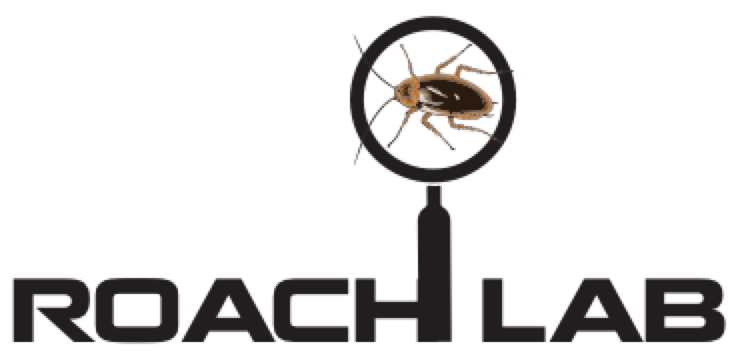Cockroach Resources
Here you will find a collection of resources about cockroaches that may help you with your roach projects.
Cockroach Ecology
To get started, there is a fantastic book on cockroach ecology that can help familiarize you with their behavior. While this book does not focus on the species we use, Blaberus discoidialis, it does provide a wealth of information on cockroaches generally. We highly recommend this book.
Bell, W.J., Roth, L.M., & Nalepa, C.A. (2007). Cockroaches: Ecology, Behavior, and Natural History. Johns Hopkins University Press, Baltimore
Getting Cockroaches
Need roaches? You can buy discoid roaches from various suppliers on the internet. They are sold as feeder insects for reptiles, so are fairly inexpensive. You will need to plan ahead though, as they can’t be shipped in the winter because it is too cold. We use Joe’s Bugz, but again, they are available from a variety of vendors.
If you want to implement the roach model in your classroom, you can also contact us. If we have extra roaches we would be happy to send some to you.
Caring for Cockroaches
Since you will be maintaining cockroaches, it is important to know how to care for them.
Please see the links below:
Roach Lab Cockroach Husbandry Guide
Roach Crossing’s Cockroach Husbandry Guide
Terrestrial Invertebrate Taxon Advisory Group Cockroach Husbandry Guides
Note: Cockroaches are often maintained as feeder insects for reptiles, so some places on the Internet have extremely basic guides for maintaining them. However, we recommend the sources listed above as they give what we consider good advice on how to maintain your colony.
Neuroscience and Cockroaches
Backyard Brains is a really cool company that sells relatively affordable neuroscience equipment, some of which is designed to be used with cockroaches. In fact, this is how we got started with our roaches!
Using roaches and equipment from Backyard Brains, you can do things like record neurons firing and even wirelessly control a cyborg roach. Check out their experiments page for these and other neuroscience experiments.
Behavior and Video Coding Software
BehaviorCloud is a software platform that tracks movement of animals through a maze or arena. We have found their software works great with the roaches! It allows you to create areas in the video and track the animals movement in those zones. The software automatically calculates a variety of things, such as how long the animal spent in each area. As long as student project have less than an hour of video, they can use the software for free. Of course, more extensive plans are available as well. This is well worth checking out to see if it will work for your roach projects.
Cockroach Literature
Below is a list of published articles about cockroach behavior and cognition. Some of the experiments we have posted are based on these articles. In addition, they may provide you with more ideas about what you can test with your own roaches.
Note: Some of these articles use stimuli that would be considered painful if used in humans. While most scientists think that insects cannot experience pain (because they likely do not have the emotional component of pain, but do have nociception, the ability to respond to noxious stimuli), we have chosen to not use potentially painful stimuli with our roaches.
Balderrama, N. (1980). One trial learning in the American cockroach, Periplaneta americana. Journal of Insect Physiology, 26(8), 499-504.
Brown, G.E., & Stroup, K. (1988). Learned helplessness in the cockroach (Periplaneta americana). Behavioral and Neural Biology, 50(2), 246-250. doi: 10.1016/S0163-1047(88)90921-1
Brown, S., & Strausfeld, N. (2009). The effect of age on a visual learning task in the American cockroach. Learning & Memory, 16(3), 210-223. doi:10.1101/lm.1241909
Disterhoft, J.F. (1972). Learning in the intact cockroach (Periplaneta americana) when placed in a punishment situation. Journal of Comparative and Physiological Psychology, 79(1), 1-7. doi:10.1037/h0032557
Ewing, L.S. (1972). Hierarchy and its relation to territory in the cockroach Nauphoeta cinerea. Behaviour, 42(1), 152-174.
Lent, D.D., & Kwon, H.-W. (2003). Antennal movements reveal associative learning in the American cockroach Periplaneta americana. Journal of Experimental Biology, 207(2), 369.
Longo, N. (1964). Probability-learning and habit-reversal in the cockroach. The American Journal of Psychology, 77(1), 29-41. doi:10.2307/1419269
Minami, H., & Dallenbach, K.M. (1946). The effect of activity upon learning and retention in the cockroach, Periplaneta americana. The American Journal of Psychology, 59(1), 1-58.
Planas-Sitja, I., Deneubourg, J.L., Gibon, C., & Sempo, G. (2015). Group personality during collective decision-making: A multi-level approach. Proceedings of the Royal Society B: Biological Sciences, 282(1802). doi:10.1098/rspb.2014.2515
Rick, J.T., Oliver, G.W.O., & Kerkut, G.A. (1972). Acquisition, extinction and reacquisition of a conditioned response in the cockroach: The effects of orotic acid. Quarterly Journal of Experimental Psychology, 24(3), 282-286. doi:10.1080/14640747208400282
Sakura, M., & Mizunami, M. (2001). Olfactory learning and memory in the cockroach Periplaneta americana. Zoological Science, 18(1), 21-28. doi:10.2108/zsj.18.21
Sato, C., Matsumoto, Y., Sakura, M., & Mizunami, M. (2006). Contextual olfactory learning in cockroaches. NeuroReport, 17(5), 553-557. doi:10.1097/01.wnr.0000209002.17610.79
Watanabe, H., Kobayashi, Y., Sakura, M., Matsumoto, Y., & Mizunami, M. (2003). Classical olfactory conditioning in the cockroach Periplaneta americana. Zoological Science, 20(12), 1447-1454. doi:10.2108/zsj.20.1447
Watanabe, H., & Mizunami, M. (2007). Pavlov's cockroach: Classical conditioning of salivation in an insect. PLoS ONE, 2(6), e529. doi:10.1371/journal.pone.0000529
Zajonc, R. B., Heingartner, A., & Herman, E. M. (1969). Social enhancement and impairment of performance in the cockroach. Journal of Personality and Social Psychology, 13(2), 83-92. doi:10.1037/h0028063
